Human Resource Management Report: Key HRM Concepts
VerifiedAdded on 2020/01/16
|16
|5293
|243
Report
AI Summary
This report delves into the multifaceted world of Human Resource Management (HRM). It begins by differentiating between personal management and HRM, outlining the core functions of HRM, and exploring the roles and responsibilities of line managers. The report then examines the impact of the legal framework on HRM practices. Task 2 focuses on human resource planning, discussing its importance, stages, and the processes of recruitment and selection. Task 3 investigates motivational theories, reward systems, job evaluation, and performance monitoring. Finally, Task 4 addresses employment cessation, procedures, and the influence of the legal framework on termination. The report covers a wide range of HRM topics, providing valuable insights into the field.
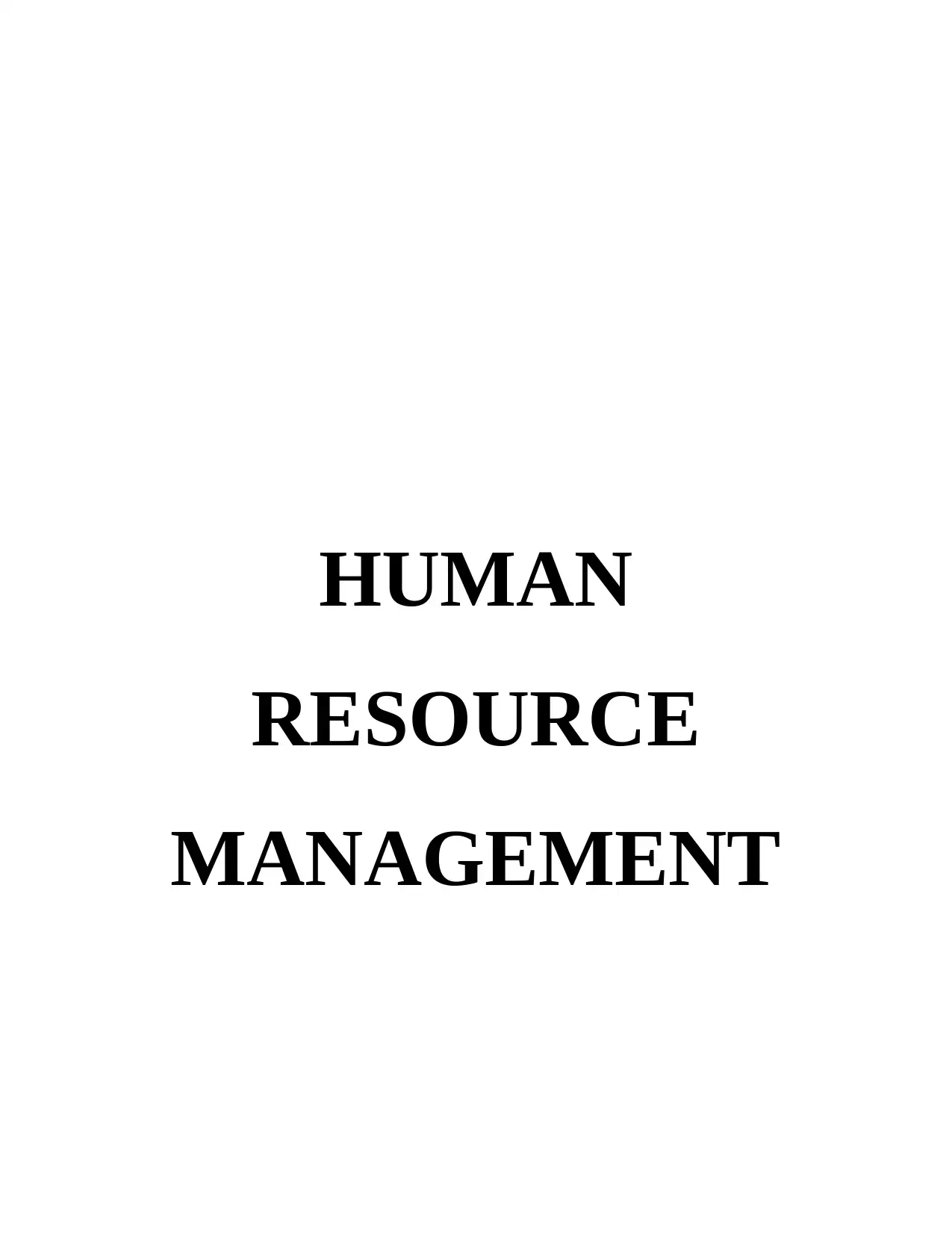
HUMAN
RESOURCE
MANAGEMENT
RESOURCE
MANAGEMENT
Paraphrase This Document
Need a fresh take? Get an instant paraphrase of this document with our AI Paraphraser
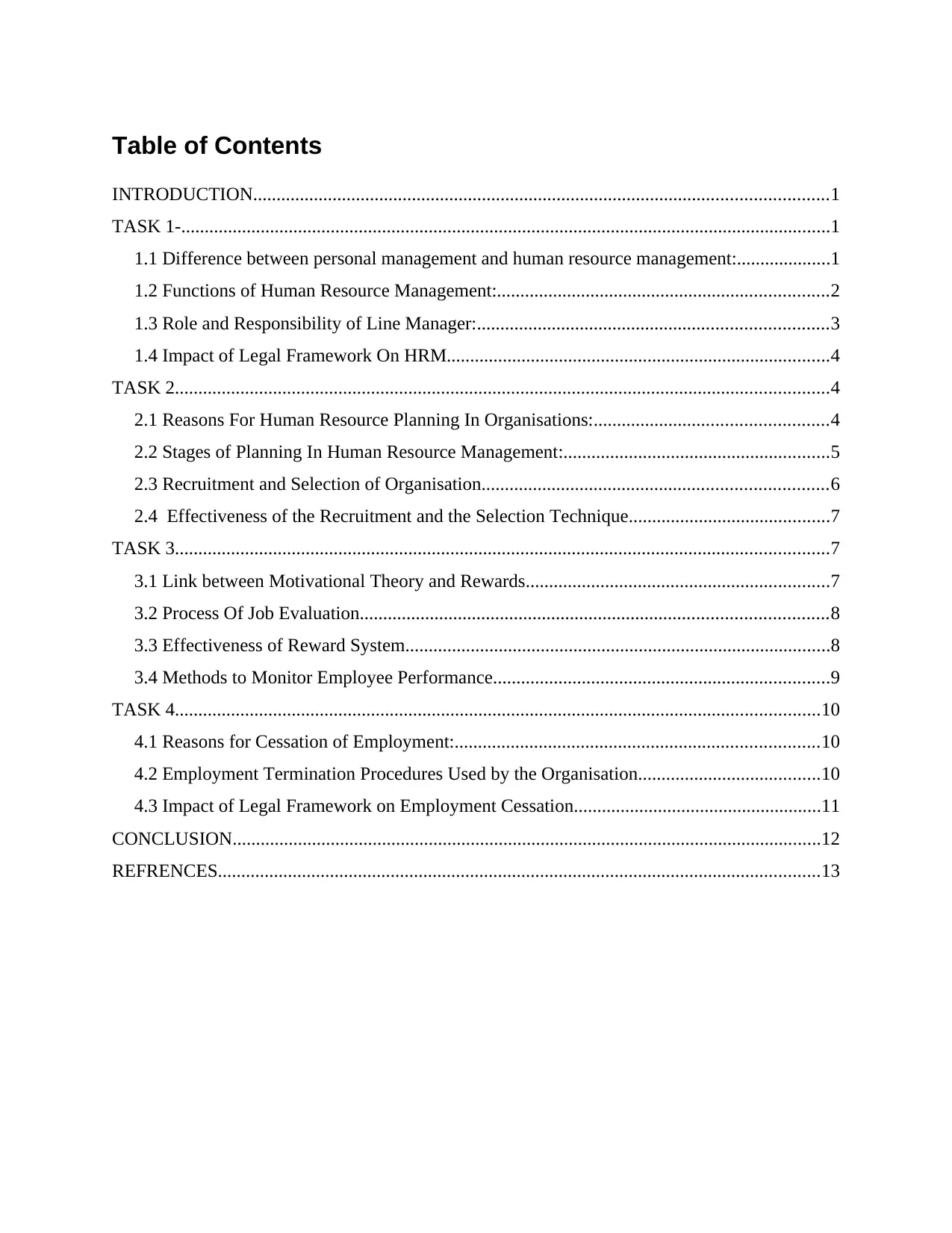
Table of Contents
INTRODUCTION...........................................................................................................................1
TASK 1-...........................................................................................................................................1
1.1 Difference between personal management and human resource management:....................1
1.2 Functions of Human Resource Management:.......................................................................2
1.3 Role and Responsibility of Line Manager:...........................................................................3
1.4 Impact of Legal Framework On HRM..................................................................................4
TASK 2............................................................................................................................................4
2.1 Reasons For Human Resource Planning In Organisations:..................................................4
2.2 Stages of Planning In Human Resource Management:.........................................................5
2.3 Recruitment and Selection of Organisation..........................................................................6
2.4 Effectiveness of the Recruitment and the Selection Technique...........................................7
TASK 3............................................................................................................................................7
3.1 Link between Motivational Theory and Rewards.................................................................7
3.2 Process Of Job Evaluation....................................................................................................8
3.3 Effectiveness of Reward System...........................................................................................8
3.4 Methods to Monitor Employee Performance........................................................................9
TASK 4..........................................................................................................................................10
4.1 Reasons for Cessation of Employment:..............................................................................10
4.2 Employment Termination Procedures Used by the Organisation.......................................10
4.3 Impact of Legal Framework on Employment Cessation.....................................................11
CONCLUSION..............................................................................................................................12
REFRENCES.................................................................................................................................13
INTRODUCTION...........................................................................................................................1
TASK 1-...........................................................................................................................................1
1.1 Difference between personal management and human resource management:....................1
1.2 Functions of Human Resource Management:.......................................................................2
1.3 Role and Responsibility of Line Manager:...........................................................................3
1.4 Impact of Legal Framework On HRM..................................................................................4
TASK 2............................................................................................................................................4
2.1 Reasons For Human Resource Planning In Organisations:..................................................4
2.2 Stages of Planning In Human Resource Management:.........................................................5
2.3 Recruitment and Selection of Organisation..........................................................................6
2.4 Effectiveness of the Recruitment and the Selection Technique...........................................7
TASK 3............................................................................................................................................7
3.1 Link between Motivational Theory and Rewards.................................................................7
3.2 Process Of Job Evaluation....................................................................................................8
3.3 Effectiveness of Reward System...........................................................................................8
3.4 Methods to Monitor Employee Performance........................................................................9
TASK 4..........................................................................................................................................10
4.1 Reasons for Cessation of Employment:..............................................................................10
4.2 Employment Termination Procedures Used by the Organisation.......................................10
4.3 Impact of Legal Framework on Employment Cessation.....................................................11
CONCLUSION..............................................................................................................................12
REFRENCES.................................................................................................................................13
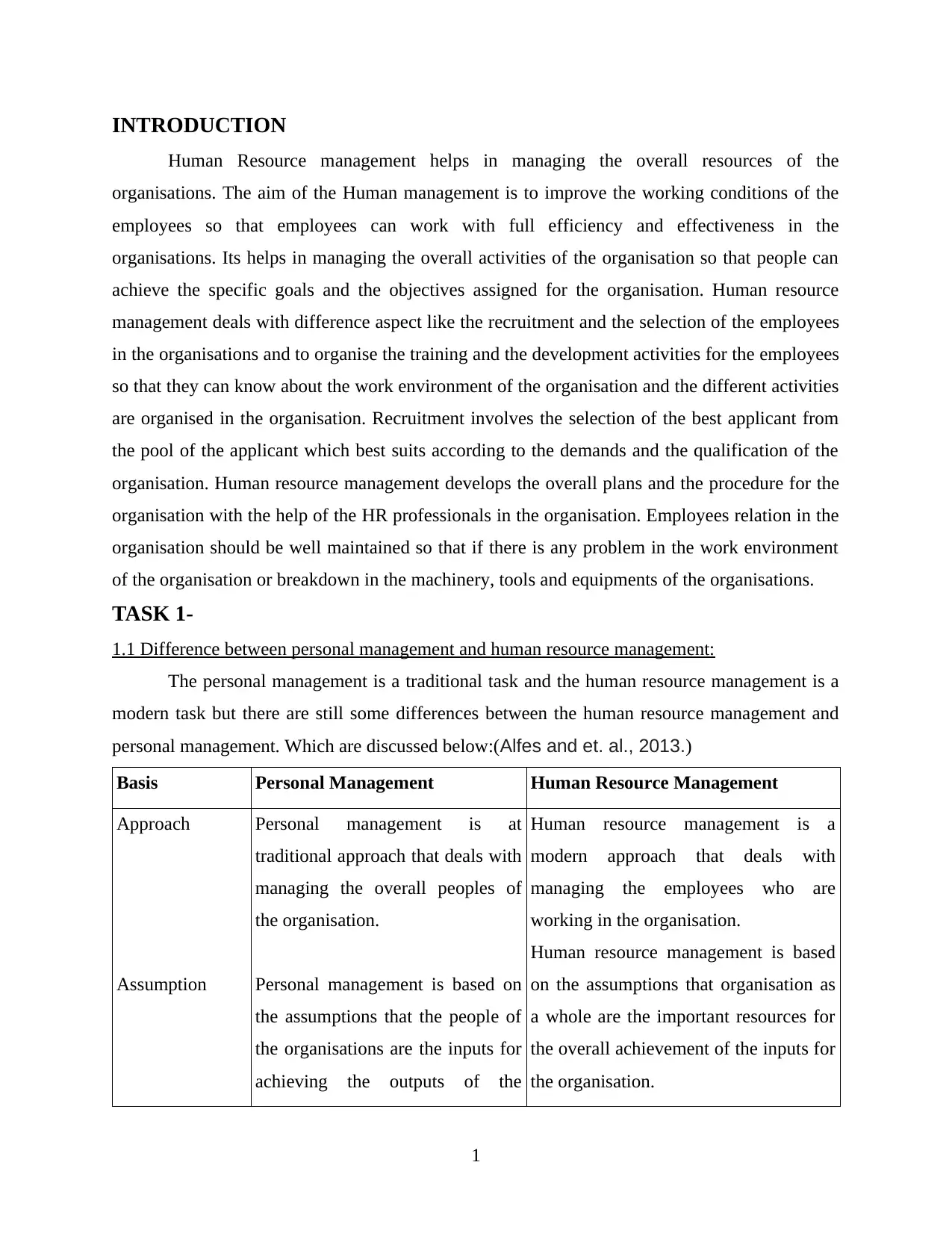
INTRODUCTION
Human Resource management helps in managing the overall resources of the
organisations. The aim of the Human management is to improve the working conditions of the
employees so that employees can work with full efficiency and effectiveness in the
organisations. Its helps in managing the overall activities of the organisation so that people can
achieve the specific goals and the objectives assigned for the organisation. Human resource
management deals with difference aspect like the recruitment and the selection of the employees
in the organisations and to organise the training and the development activities for the employees
so that they can know about the work environment of the organisation and the different activities
are organised in the organisation. Recruitment involves the selection of the best applicant from
the pool of the applicant which best suits according to the demands and the qualification of the
organisation. Human resource management develops the overall plans and the procedure for the
organisation with the help of the HR professionals in the organisation. Employees relation in the
organisation should be well maintained so that if there is any problem in the work environment
of the organisation or breakdown in the machinery, tools and equipments of the organisations.
TASK 1-
1.1 Difference between personal management and human resource management:
The personal management is a traditional task and the human resource management is a
modern task but there are still some differences between the human resource management and
personal management. Which are discussed below:(Alfes and et. al., 2013.)
Basis Personal Management Human Resource Management
Approach
Assumption
Personal management is at
traditional approach that deals with
managing the overall peoples of
the organisation.
Personal management is based on
the assumptions that the people of
the organisations are the inputs for
achieving the outputs of the
Human resource management is a
modern approach that deals with
managing the employees who are
working in the organisation.
Human resource management is based
on the assumptions that organisation as
a whole are the important resources for
the overall achievement of the inputs for
the organisation.
1
Human Resource management helps in managing the overall resources of the
organisations. The aim of the Human management is to improve the working conditions of the
employees so that employees can work with full efficiency and effectiveness in the
organisations. Its helps in managing the overall activities of the organisation so that people can
achieve the specific goals and the objectives assigned for the organisation. Human resource
management deals with difference aspect like the recruitment and the selection of the employees
in the organisations and to organise the training and the development activities for the employees
so that they can know about the work environment of the organisation and the different activities
are organised in the organisation. Recruitment involves the selection of the best applicant from
the pool of the applicant which best suits according to the demands and the qualification of the
organisation. Human resource management develops the overall plans and the procedure for the
organisation with the help of the HR professionals in the organisation. Employees relation in the
organisation should be well maintained so that if there is any problem in the work environment
of the organisation or breakdown in the machinery, tools and equipments of the organisations.
TASK 1-
1.1 Difference between personal management and human resource management:
The personal management is a traditional task and the human resource management is a
modern task but there are still some differences between the human resource management and
personal management. Which are discussed below:(Alfes and et. al., 2013.)
Basis Personal Management Human Resource Management
Approach
Assumption
Personal management is at
traditional approach that deals with
managing the overall peoples of
the organisation.
Personal management is based on
the assumptions that the people of
the organisations are the inputs for
achieving the outputs of the
Human resource management is a
modern approach that deals with
managing the employees who are
working in the organisation.
Human resource management is based
on the assumptions that organisation as
a whole are the important resources for
the overall achievement of the inputs for
the organisation.
1
⊘ This is a preview!⊘
Do you want full access?
Subscribe today to unlock all pages.

Trusted by 1+ million students worldwide
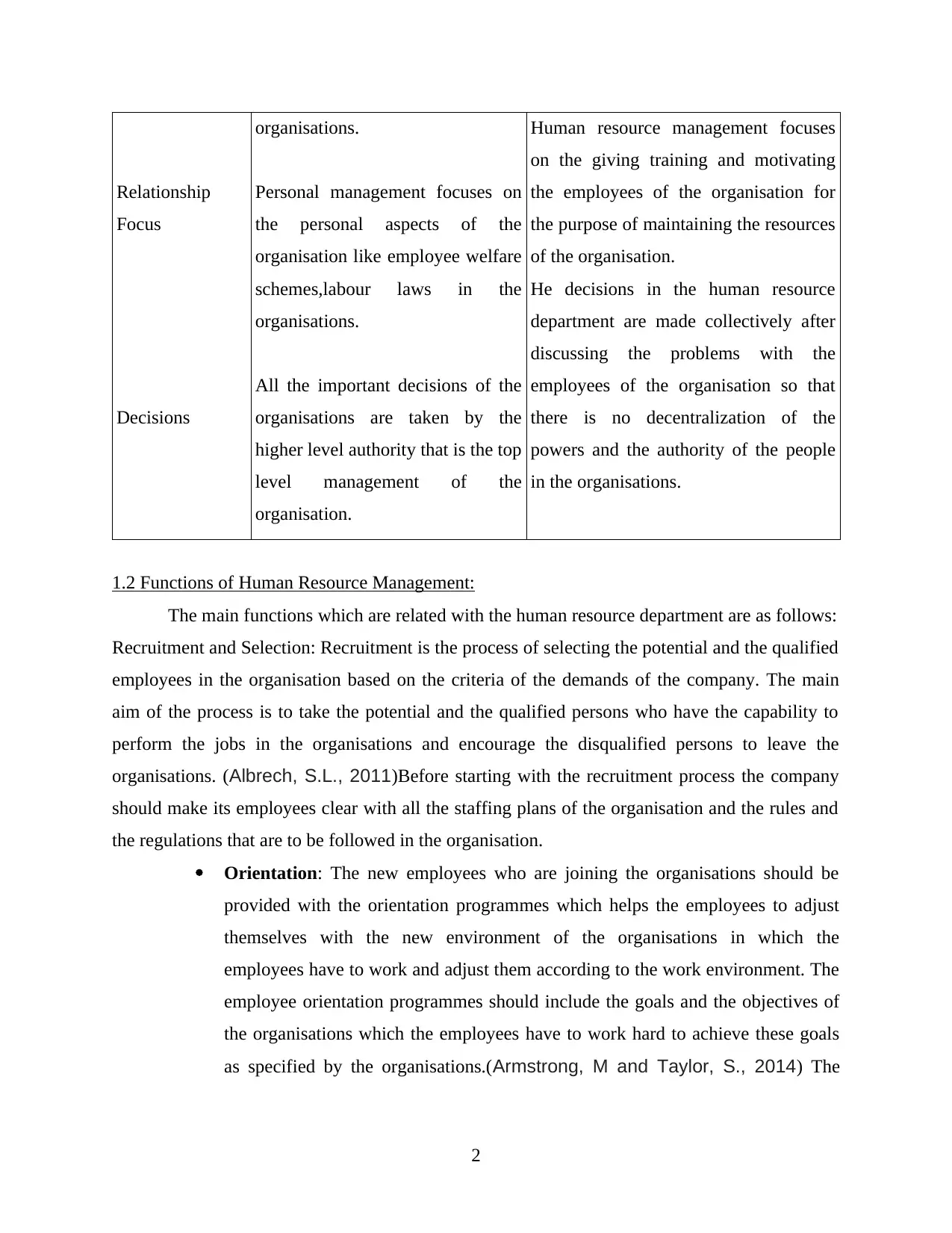
Relationship
Focus
Decisions
organisations.
Personal management focuses on
the personal aspects of the
organisation like employee welfare
schemes,labour laws in the
organisations.
All the important decisions of the
organisations are taken by the
higher level authority that is the top
level management of the
organisation.
Human resource management focuses
on the giving training and motivating
the employees of the organisation for
the purpose of maintaining the resources
of the organisation.
He decisions in the human resource
department are made collectively after
discussing the problems with the
employees of the organisation so that
there is no decentralization of the
powers and the authority of the people
in the organisations.
1.2 Functions of Human Resource Management:
The main functions which are related with the human resource department are as follows:
Recruitment and Selection: Recruitment is the process of selecting the potential and the qualified
employees in the organisation based on the criteria of the demands of the company. The main
aim of the process is to take the potential and the qualified persons who have the capability to
perform the jobs in the organisations and encourage the disqualified persons to leave the
organisations. (Albrech, S.L., 2011)Before starting with the recruitment process the company
should make its employees clear with all the staffing plans of the organisation and the rules and
the regulations that are to be followed in the organisation.
Orientation: The new employees who are joining the organisations should be
provided with the orientation programmes which helps the employees to adjust
themselves with the new environment of the organisations in which the
employees have to work and adjust them according to the work environment. The
employee orientation programmes should include the goals and the objectives of
the organisations which the employees have to work hard to achieve these goals
as specified by the organisations.(Armstrong, M and Taylor, S., 2014) The
2
Focus
Decisions
organisations.
Personal management focuses on
the personal aspects of the
organisation like employee welfare
schemes,labour laws in the
organisations.
All the important decisions of the
organisations are taken by the
higher level authority that is the top
level management of the
organisation.
Human resource management focuses
on the giving training and motivating
the employees of the organisation for
the purpose of maintaining the resources
of the organisation.
He decisions in the human resource
department are made collectively after
discussing the problems with the
employees of the organisation so that
there is no decentralization of the
powers and the authority of the people
in the organisations.
1.2 Functions of Human Resource Management:
The main functions which are related with the human resource department are as follows:
Recruitment and Selection: Recruitment is the process of selecting the potential and the qualified
employees in the organisation based on the criteria of the demands of the company. The main
aim of the process is to take the potential and the qualified persons who have the capability to
perform the jobs in the organisations and encourage the disqualified persons to leave the
organisations. (Albrech, S.L., 2011)Before starting with the recruitment process the company
should make its employees clear with all the staffing plans of the organisation and the rules and
the regulations that are to be followed in the organisation.
Orientation: The new employees who are joining the organisations should be
provided with the orientation programmes which helps the employees to adjust
themselves with the new environment of the organisations in which the
employees have to work and adjust them according to the work environment. The
employee orientation programmes should include the goals and the objectives of
the organisations which the employees have to work hard to achieve these goals
as specified by the organisations.(Armstrong, M and Taylor, S., 2014) The
2
Paraphrase This Document
Need a fresh take? Get an instant paraphrase of this document with our AI Paraphraser
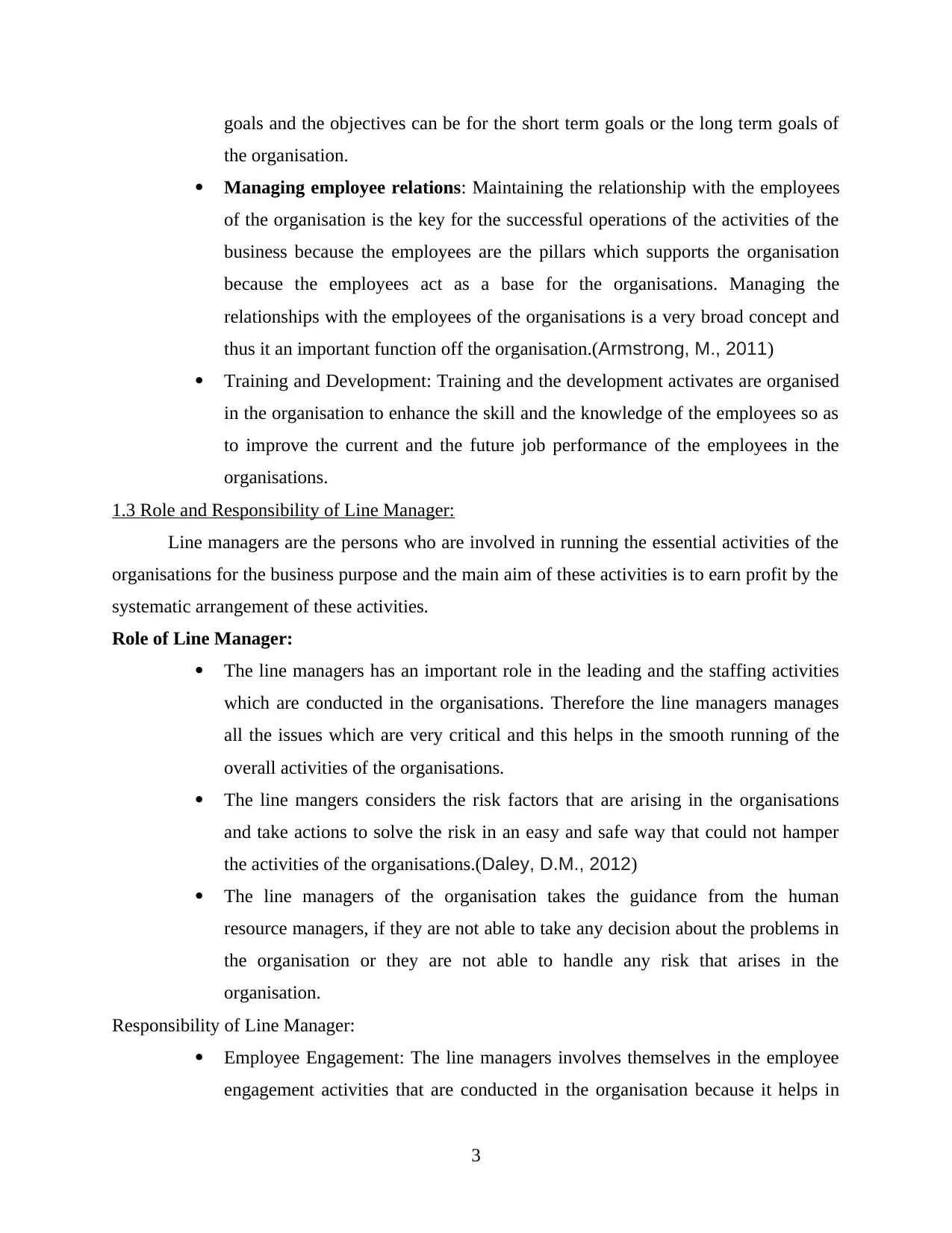
goals and the objectives can be for the short term goals or the long term goals of
the organisation.
Managing employee relations: Maintaining the relationship with the employees
of the organisation is the key for the successful operations of the activities of the
business because the employees are the pillars which supports the organisation
because the employees act as a base for the organisations. Managing the
relationships with the employees of the organisations is a very broad concept and
thus it an important function off the organisation.(Armstrong, M., 2011)
Training and Development: Training and the development activates are organised
in the organisation to enhance the skill and the knowledge of the employees so as
to improve the current and the future job performance of the employees in the
organisations.
1.3 Role and Responsibility of Line Manager:
Line managers are the persons who are involved in running the essential activities of the
organisations for the business purpose and the main aim of these activities is to earn profit by the
systematic arrangement of these activities.
Role of Line Manager:
The line managers has an important role in the leading and the staffing activities
which are conducted in the organisations. Therefore the line managers manages
all the issues which are very critical and this helps in the smooth running of the
overall activities of the organisations.
The line mangers considers the risk factors that are arising in the organisations
and take actions to solve the risk in an easy and safe way that could not hamper
the activities of the organisations.(Daley, D.M., 2012)
The line managers of the organisation takes the guidance from the human
resource managers, if they are not able to take any decision about the problems in
the organisation or they are not able to handle any risk that arises in the
organisation.
Responsibility of Line Manager:
Employee Engagement: The line managers involves themselves in the employee
engagement activities that are conducted in the organisation because it helps in
3
the organisation.
Managing employee relations: Maintaining the relationship with the employees
of the organisation is the key for the successful operations of the activities of the
business because the employees are the pillars which supports the organisation
because the employees act as a base for the organisations. Managing the
relationships with the employees of the organisations is a very broad concept and
thus it an important function off the organisation.(Armstrong, M., 2011)
Training and Development: Training and the development activates are organised
in the organisation to enhance the skill and the knowledge of the employees so as
to improve the current and the future job performance of the employees in the
organisations.
1.3 Role and Responsibility of Line Manager:
Line managers are the persons who are involved in running the essential activities of the
organisations for the business purpose and the main aim of these activities is to earn profit by the
systematic arrangement of these activities.
Role of Line Manager:
The line managers has an important role in the leading and the staffing activities
which are conducted in the organisations. Therefore the line managers manages
all the issues which are very critical and this helps in the smooth running of the
overall activities of the organisations.
The line mangers considers the risk factors that are arising in the organisations
and take actions to solve the risk in an easy and safe way that could not hamper
the activities of the organisations.(Daley, D.M., 2012)
The line managers of the organisation takes the guidance from the human
resource managers, if they are not able to take any decision about the problems in
the organisation or they are not able to handle any risk that arises in the
organisation.
Responsibility of Line Manager:
Employee Engagement: The line managers involves themselves in the employee
engagement activities that are conducted in the organisation because it helps in
3

encouraging open communication between the employees so that if the employees
have any problem they can discuss the problems and thus the problem can be
solved. The line managers motivates the employees to use their skills and abilities
in performing the activities of the organisation.
Performance Appraisal: Line mangers conduct the performance appraisal for the
employees. The performance appraisal helps in evaluation of the overall
performance of the employees and thus giving them rating, promotions and giving
necessary feedback if the employee is lacking in some areas. Performance
appraisal motivates the employees towards the work and the organisation.
1.4 Impact of Legal Framework On HRM
The employment legislation are concerned with the body of the laws that helps in the
smooth running and functioning of the policies and the programmes in the organisation. The
legal framework includes the issues related with the discrimination at the work places,conditions
of the work environment in the organisation. (Berman and et. al., 2012)The health and the
safety issues in the organisation.
Equal Payment Act (1970): The equal payment act of 1970 states that all the
persons employed in the organisation have the right to get equal pay for the same
work done. There should be no discrimination in the organisation based on the
sex, caste, religion and cast. All the person employed have the equal right to pay.
National Minimum Wage Act(1998): The national minimum wage act implies
that a person employed in any organisation have access to the minimum wages as
fixed by the government. The process to give wages to the employees depends on
the policies of the company according to monthly or weekly basis of pay
structure. The company can pay higher wages to the employees for the extra effort
put by the employees in the organisation but not lower than the prices fixed by the
government.(Bloom, N and Van Reenen, J., 2011)
TASK 2
2.1 Reasons For Human Resource Planning In Organisations:
Human resource planning deals with the systematic approach of the accessing the
needs of the human resource department. Planning helps to ensure that the right
number of the people are selected for the right job and at right time of work.
4
have any problem they can discuss the problems and thus the problem can be
solved. The line managers motivates the employees to use their skills and abilities
in performing the activities of the organisation.
Performance Appraisal: Line mangers conduct the performance appraisal for the
employees. The performance appraisal helps in evaluation of the overall
performance of the employees and thus giving them rating, promotions and giving
necessary feedback if the employee is lacking in some areas. Performance
appraisal motivates the employees towards the work and the organisation.
1.4 Impact of Legal Framework On HRM
The employment legislation are concerned with the body of the laws that helps in the
smooth running and functioning of the policies and the programmes in the organisation. The
legal framework includes the issues related with the discrimination at the work places,conditions
of the work environment in the organisation. (Berman and et. al., 2012)The health and the
safety issues in the organisation.
Equal Payment Act (1970): The equal payment act of 1970 states that all the
persons employed in the organisation have the right to get equal pay for the same
work done. There should be no discrimination in the organisation based on the
sex, caste, religion and cast. All the person employed have the equal right to pay.
National Minimum Wage Act(1998): The national minimum wage act implies
that a person employed in any organisation have access to the minimum wages as
fixed by the government. The process to give wages to the employees depends on
the policies of the company according to monthly or weekly basis of pay
structure. The company can pay higher wages to the employees for the extra effort
put by the employees in the organisation but not lower than the prices fixed by the
government.(Bloom, N and Van Reenen, J., 2011)
TASK 2
2.1 Reasons For Human Resource Planning In Organisations:
Human resource planning deals with the systematic approach of the accessing the
needs of the human resource department. Planning helps to ensure that the right
number of the people are selected for the right job and at right time of work.
4
⊘ This is a preview!⊘
Do you want full access?
Subscribe today to unlock all pages.

Trusted by 1+ million students worldwide

An organisation human resource department deals with the recruitment, training
and career development of the people of the organisation. The human resource
planning is an important aspect for the organisation because it helps in the
recruitment of the right number of the employees which best suits with the
requirement of the organisation. HR planning also deals with the effectively and
efficient utilization of the resources so as to sustain the employees in the
organisations.
Human resource planning helps in advancement of the planning for the new
development of the plans and the objectives for the activities and how these
activities can be successful in achievement of the organisational goals. Planning
in advance helps an individual to get an idea about how the different activities
will be coordinated in the work organisation.( Boxall, P. and Purcell, J., 2011)
2.2 Stages of Planning In Human Resource Management:
There are several stages which helps in the planning of the activities in the organisation which
are described as:
Data Collection: Data collection helps in the planning of the human resource
activities Data collection helps in the identification of the goals and the objectives
which are to be achieved by the organisations in the short or the long run where
the organisation want to achieve success. Data collection also includes keeping
the record of the materials that are available at the work place. It also includes
keeping a track on the number of the persons working in the organisations and the
work structure assigned to them.(Bratton, J and Gold, J., 2012)
Auditing: Auditing involves keeping an eye ion the strategic market conditions
that are prevailing in the market and the strategic objectives of the organisation.
Auditing helps to know the past performance of the employees in the organisation
and linking the past performances of the employees with the current performance
so as to know the changes in the performance of the employees over the year.
Demand and Supply: Demand and the supply factor in the organisation helps an
individual to know about the quality of the individual and the work a company
should employee in its organisation.
5
and career development of the people of the organisation. The human resource
planning is an important aspect for the organisation because it helps in the
recruitment of the right number of the employees which best suits with the
requirement of the organisation. HR planning also deals with the effectively and
efficient utilization of the resources so as to sustain the employees in the
organisations.
Human resource planning helps in advancement of the planning for the new
development of the plans and the objectives for the activities and how these
activities can be successful in achievement of the organisational goals. Planning
in advance helps an individual to get an idea about how the different activities
will be coordinated in the work organisation.( Boxall, P. and Purcell, J., 2011)
2.2 Stages of Planning In Human Resource Management:
There are several stages which helps in the planning of the activities in the organisation which
are described as:
Data Collection: Data collection helps in the planning of the human resource
activities Data collection helps in the identification of the goals and the objectives
which are to be achieved by the organisations in the short or the long run where
the organisation want to achieve success. Data collection also includes keeping
the record of the materials that are available at the work place. It also includes
keeping a track on the number of the persons working in the organisations and the
work structure assigned to them.(Bratton, J and Gold, J., 2012)
Auditing: Auditing involves keeping an eye ion the strategic market conditions
that are prevailing in the market and the strategic objectives of the organisation.
Auditing helps to know the past performance of the employees in the organisation
and linking the past performances of the employees with the current performance
so as to know the changes in the performance of the employees over the year.
Demand and Supply: Demand and the supply factor in the organisation helps an
individual to know about the quality of the individual and the work a company
should employee in its organisation.
5
Paraphrase This Document
Need a fresh take? Get an instant paraphrase of this document with our AI Paraphraser
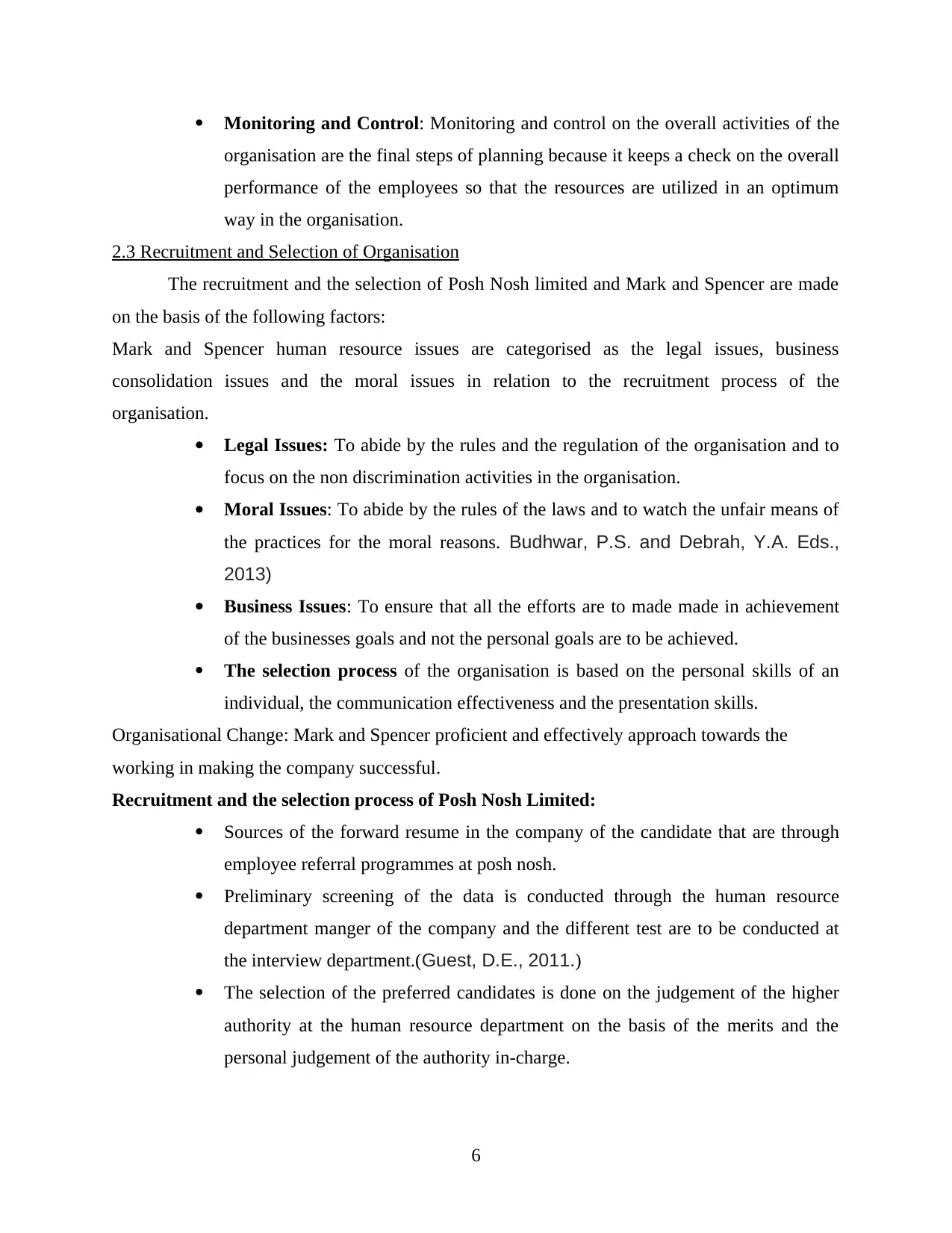
Monitoring and Control: Monitoring and control on the overall activities of the
organisation are the final steps of planning because it keeps a check on the overall
performance of the employees so that the resources are utilized in an optimum
way in the organisation.
2.3 Recruitment and Selection of Organisation
The recruitment and the selection of Posh Nosh limited and Mark and Spencer are made
on the basis of the following factors:
Mark and Spencer human resource issues are categorised as the legal issues, business
consolidation issues and the moral issues in relation to the recruitment process of the
organisation.
Legal Issues: To abide by the rules and the regulation of the organisation and to
focus on the non discrimination activities in the organisation.
Moral Issues: To abide by the rules of the laws and to watch the unfair means of
the practices for the moral reasons. Budhwar, P.S. and Debrah, Y.A. Eds.,
2013)
Business Issues: To ensure that all the efforts are to made made in achievement
of the businesses goals and not the personal goals are to be achieved.
The selection process of the organisation is based on the personal skills of an
individual, the communication effectiveness and the presentation skills.
Organisational Change: Mark and Spencer proficient and effectively approach towards the
working in making the company successful.
Recruitment and the selection process of Posh Nosh Limited:
Sources of the forward resume in the company of the candidate that are through
employee referral programmes at posh nosh.
Preliminary screening of the data is conducted through the human resource
department manger of the company and the different test are to be conducted at
the interview department.(Guest, D.E., 2011.)
The selection of the preferred candidates is done on the judgement of the higher
authority at the human resource department on the basis of the merits and the
personal judgement of the authority in-charge.
6
organisation are the final steps of planning because it keeps a check on the overall
performance of the employees so that the resources are utilized in an optimum
way in the organisation.
2.3 Recruitment and Selection of Organisation
The recruitment and the selection of Posh Nosh limited and Mark and Spencer are made
on the basis of the following factors:
Mark and Spencer human resource issues are categorised as the legal issues, business
consolidation issues and the moral issues in relation to the recruitment process of the
organisation.
Legal Issues: To abide by the rules and the regulation of the organisation and to
focus on the non discrimination activities in the organisation.
Moral Issues: To abide by the rules of the laws and to watch the unfair means of
the practices for the moral reasons. Budhwar, P.S. and Debrah, Y.A. Eds.,
2013)
Business Issues: To ensure that all the efforts are to made made in achievement
of the businesses goals and not the personal goals are to be achieved.
The selection process of the organisation is based on the personal skills of an
individual, the communication effectiveness and the presentation skills.
Organisational Change: Mark and Spencer proficient and effectively approach towards the
working in making the company successful.
Recruitment and the selection process of Posh Nosh Limited:
Sources of the forward resume in the company of the candidate that are through
employee referral programmes at posh nosh.
Preliminary screening of the data is conducted through the human resource
department manger of the company and the different test are to be conducted at
the interview department.(Guest, D.E., 2011.)
The selection of the preferred candidates is done on the judgement of the higher
authority at the human resource department on the basis of the merits and the
personal judgement of the authority in-charge.
6
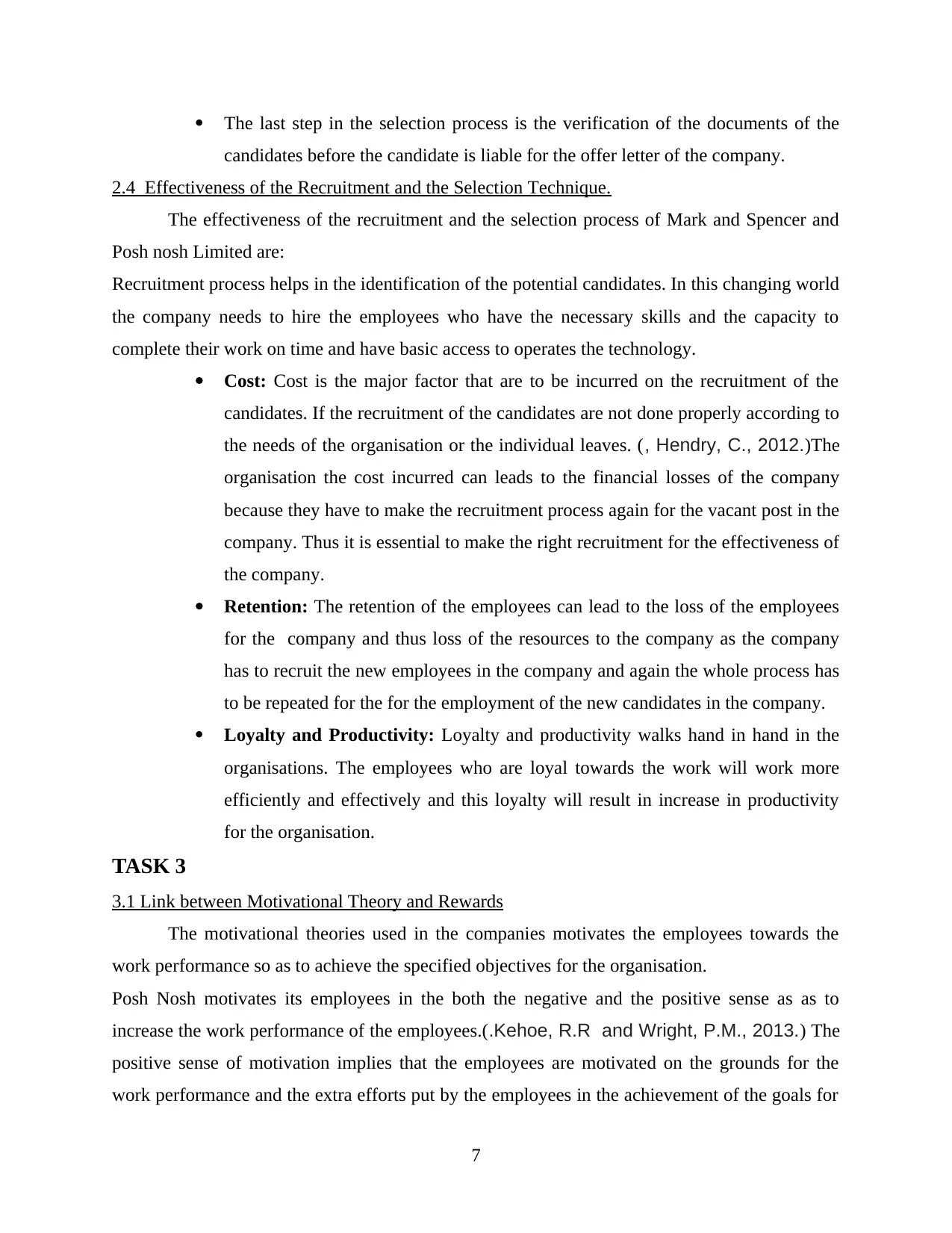
The last step in the selection process is the verification of the documents of the
candidates before the candidate is liable for the offer letter of the company.
2.4 Effectiveness of the Recruitment and the Selection Technique.
The effectiveness of the recruitment and the selection process of Mark and Spencer and
Posh nosh Limited are:
Recruitment process helps in the identification of the potential candidates. In this changing world
the company needs to hire the employees who have the necessary skills and the capacity to
complete their work on time and have basic access to operates the technology.
Cost: Cost is the major factor that are to be incurred on the recruitment of the
candidates. If the recruitment of the candidates are not done properly according to
the needs of the organisation or the individual leaves. (, Hendry, C., 2012.)The
organisation the cost incurred can leads to the financial losses of the company
because they have to make the recruitment process again for the vacant post in the
company. Thus it is essential to make the right recruitment for the effectiveness of
the company.
Retention: The retention of the employees can lead to the loss of the employees
for the company and thus loss of the resources to the company as the company
has to recruit the new employees in the company and again the whole process has
to be repeated for the for the employment of the new candidates in the company.
Loyalty and Productivity: Loyalty and productivity walks hand in hand in the
organisations. The employees who are loyal towards the work will work more
efficiently and effectively and this loyalty will result in increase in productivity
for the organisation.
TASK 3
3.1 Link between Motivational Theory and Rewards
The motivational theories used in the companies motivates the employees towards the
work performance so as to achieve the specified objectives for the organisation.
Posh Nosh motivates its employees in the both the negative and the positive sense as as to
increase the work performance of the employees.(.Kehoe, R.R and Wright, P.M., 2013.) The
positive sense of motivation implies that the employees are motivated on the grounds for the
work performance and the extra efforts put by the employees in the achievement of the goals for
7
candidates before the candidate is liable for the offer letter of the company.
2.4 Effectiveness of the Recruitment and the Selection Technique.
The effectiveness of the recruitment and the selection process of Mark and Spencer and
Posh nosh Limited are:
Recruitment process helps in the identification of the potential candidates. In this changing world
the company needs to hire the employees who have the necessary skills and the capacity to
complete their work on time and have basic access to operates the technology.
Cost: Cost is the major factor that are to be incurred on the recruitment of the
candidates. If the recruitment of the candidates are not done properly according to
the needs of the organisation or the individual leaves. (, Hendry, C., 2012.)The
organisation the cost incurred can leads to the financial losses of the company
because they have to make the recruitment process again for the vacant post in the
company. Thus it is essential to make the right recruitment for the effectiveness of
the company.
Retention: The retention of the employees can lead to the loss of the employees
for the company and thus loss of the resources to the company as the company
has to recruit the new employees in the company and again the whole process has
to be repeated for the for the employment of the new candidates in the company.
Loyalty and Productivity: Loyalty and productivity walks hand in hand in the
organisations. The employees who are loyal towards the work will work more
efficiently and effectively and this loyalty will result in increase in productivity
for the organisation.
TASK 3
3.1 Link between Motivational Theory and Rewards
The motivational theories used in the companies motivates the employees towards the
work performance so as to achieve the specified objectives for the organisation.
Posh Nosh motivates its employees in the both the negative and the positive sense as as to
increase the work performance of the employees.(.Kehoe, R.R and Wright, P.M., 2013.) The
positive sense of motivation implies that the employees are motivated on the grounds for the
work performance and the extra efforts put by the employees in the achievement of the goals for
7
⊘ This is a preview!⊘
Do you want full access?
Subscribe today to unlock all pages.

Trusted by 1+ million students worldwide
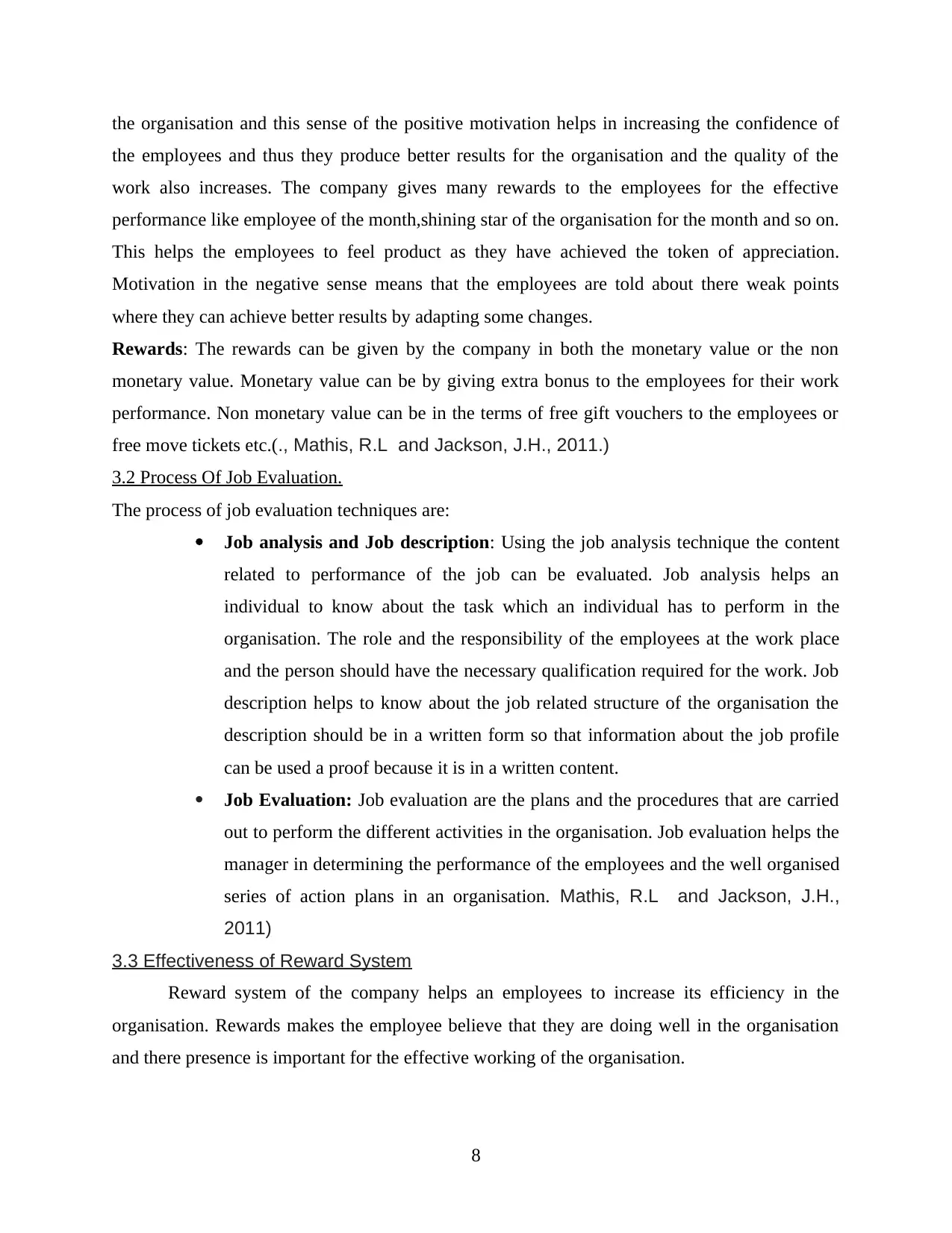
the organisation and this sense of the positive motivation helps in increasing the confidence of
the employees and thus they produce better results for the organisation and the quality of the
work also increases. The company gives many rewards to the employees for the effective
performance like employee of the month,shining star of the organisation for the month and so on.
This helps the employees to feel product as they have achieved the token of appreciation.
Motivation in the negative sense means that the employees are told about there weak points
where they can achieve better results by adapting some changes.
Rewards: The rewards can be given by the company in both the monetary value or the non
monetary value. Monetary value can be by giving extra bonus to the employees for their work
performance. Non monetary value can be in the terms of free gift vouchers to the employees or
free move tickets etc.(., Mathis, R.L and Jackson, J.H., 2011.)
3.2 Process Of Job Evaluation.
The process of job evaluation techniques are:
Job analysis and Job description: Using the job analysis technique the content
related to performance of the job can be evaluated. Job analysis helps an
individual to know about the task which an individual has to perform in the
organisation. The role and the responsibility of the employees at the work place
and the person should have the necessary qualification required for the work. Job
description helps to know about the job related structure of the organisation the
description should be in a written form so that information about the job profile
can be used a proof because it is in a written content.
Job Evaluation: Job evaluation are the plans and the procedures that are carried
out to perform the different activities in the organisation. Job evaluation helps the
manager in determining the performance of the employees and the well organised
series of action plans in an organisation. Mathis, R.L and Jackson, J.H.,
2011)
3.3 Effectiveness of Reward System
Reward system of the company helps an employees to increase its efficiency in the
organisation. Rewards makes the employee believe that they are doing well in the organisation
and there presence is important for the effective working of the organisation.
8
the employees and thus they produce better results for the organisation and the quality of the
work also increases. The company gives many rewards to the employees for the effective
performance like employee of the month,shining star of the organisation for the month and so on.
This helps the employees to feel product as they have achieved the token of appreciation.
Motivation in the negative sense means that the employees are told about there weak points
where they can achieve better results by adapting some changes.
Rewards: The rewards can be given by the company in both the monetary value or the non
monetary value. Monetary value can be by giving extra bonus to the employees for their work
performance. Non monetary value can be in the terms of free gift vouchers to the employees or
free move tickets etc.(., Mathis, R.L and Jackson, J.H., 2011.)
3.2 Process Of Job Evaluation.
The process of job evaluation techniques are:
Job analysis and Job description: Using the job analysis technique the content
related to performance of the job can be evaluated. Job analysis helps an
individual to know about the task which an individual has to perform in the
organisation. The role and the responsibility of the employees at the work place
and the person should have the necessary qualification required for the work. Job
description helps to know about the job related structure of the organisation the
description should be in a written form so that information about the job profile
can be used a proof because it is in a written content.
Job Evaluation: Job evaluation are the plans and the procedures that are carried
out to perform the different activities in the organisation. Job evaluation helps the
manager in determining the performance of the employees and the well organised
series of action plans in an organisation. Mathis, R.L and Jackson, J.H.,
2011)
3.3 Effectiveness of Reward System
Reward system of the company helps an employees to increase its efficiency in the
organisation. Rewards makes the employee believe that they are doing well in the organisation
and there presence is important for the effective working of the organisation.
8
Paraphrase This Document
Need a fresh take? Get an instant paraphrase of this document with our AI Paraphraser
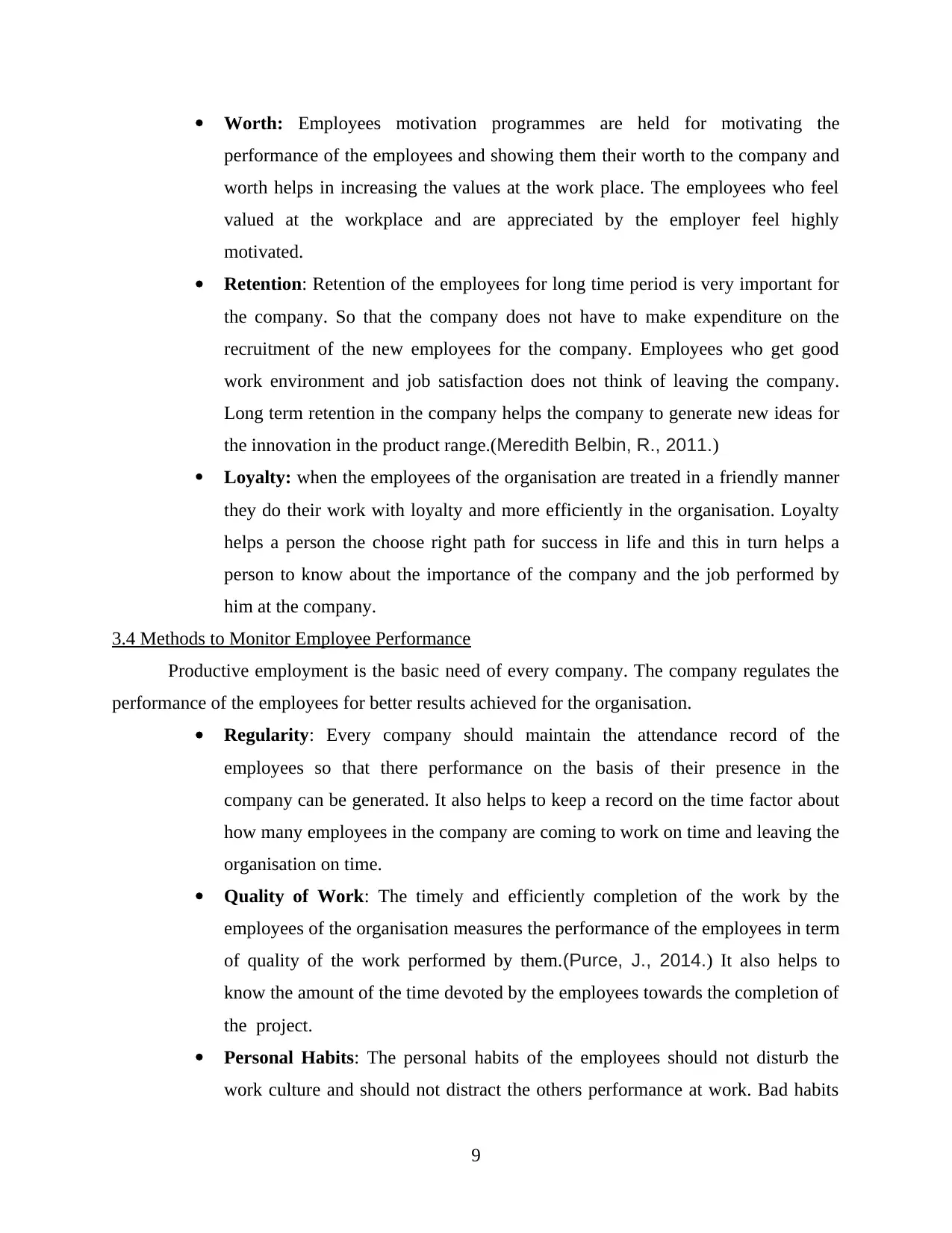
Worth: Employees motivation programmes are held for motivating the
performance of the employees and showing them their worth to the company and
worth helps in increasing the values at the work place. The employees who feel
valued at the workplace and are appreciated by the employer feel highly
motivated.
Retention: Retention of the employees for long time period is very important for
the company. So that the company does not have to make expenditure on the
recruitment of the new employees for the company. Employees who get good
work environment and job satisfaction does not think of leaving the company.
Long term retention in the company helps the company to generate new ideas for
the innovation in the product range.(Meredith Belbin, R., 2011.)
Loyalty: when the employees of the organisation are treated in a friendly manner
they do their work with loyalty and more efficiently in the organisation. Loyalty
helps a person the choose right path for success in life and this in turn helps a
person to know about the importance of the company and the job performed by
him at the company.
3.4 Methods to Monitor Employee Performance
Productive employment is the basic need of every company. The company regulates the
performance of the employees for better results achieved for the organisation.
Regularity: Every company should maintain the attendance record of the
employees so that there performance on the basis of their presence in the
company can be generated. It also helps to keep a record on the time factor about
how many employees in the company are coming to work on time and leaving the
organisation on time.
Quality of Work: The timely and efficiently completion of the work by the
employees of the organisation measures the performance of the employees in term
of quality of the work performed by them.(Purce, J., 2014.) It also helps to
know the amount of the time devoted by the employees towards the completion of
the project.
Personal Habits: The personal habits of the employees should not disturb the
work culture and should not distract the others performance at work. Bad habits
9
performance of the employees and showing them their worth to the company and
worth helps in increasing the values at the work place. The employees who feel
valued at the workplace and are appreciated by the employer feel highly
motivated.
Retention: Retention of the employees for long time period is very important for
the company. So that the company does not have to make expenditure on the
recruitment of the new employees for the company. Employees who get good
work environment and job satisfaction does not think of leaving the company.
Long term retention in the company helps the company to generate new ideas for
the innovation in the product range.(Meredith Belbin, R., 2011.)
Loyalty: when the employees of the organisation are treated in a friendly manner
they do their work with loyalty and more efficiently in the organisation. Loyalty
helps a person the choose right path for success in life and this in turn helps a
person to know about the importance of the company and the job performed by
him at the company.
3.4 Methods to Monitor Employee Performance
Productive employment is the basic need of every company. The company regulates the
performance of the employees for better results achieved for the organisation.
Regularity: Every company should maintain the attendance record of the
employees so that there performance on the basis of their presence in the
company can be generated. It also helps to keep a record on the time factor about
how many employees in the company are coming to work on time and leaving the
organisation on time.
Quality of Work: The timely and efficiently completion of the work by the
employees of the organisation measures the performance of the employees in term
of quality of the work performed by them.(Purce, J., 2014.) It also helps to
know the amount of the time devoted by the employees towards the completion of
the project.
Personal Habits: The personal habits of the employees should not disturb the
work culture and should not distract the others performance at work. Bad habits
9

can be using bad words in the workplace of destroying the equipments of the
organisation.
Random Checks: There should be random checks on the work performance of
the employees so that employees have the fear that their work could be checked at
any point of time and thus they perform quality of the work as assigned to them
by the company.
TASK 4
4.1 Reasons for Cessation of Employment:
The termination of employment conditions from the company can be due to a number of
the factors that affects the working environment of the organisation.
Inadequate Job Performance: An employee can be terminated from his work
because his job is not worth full for the company and the employee is not able to
generate the desired output for the company.(Renwick and et. al.,2013.) The
employee is not able to complete his work on time and he delays in each and
every activity of the organisation. Inefficiency in performing the job leads to loss
to the company in term of the financial resources and work productivity.
Damage Company Property: An employee can be terminated because he has
damaged the property of the company.
False Records: An employee can be terminated because he has shown fake
records of the work and not the actual work done by him. The person has copied
the facts from other employees work record and he was found false indulging in
the activities which are not accepted by the organisation.
Uninformed Leaves: A person can be terminated from the company if the person
usually takes leave without informing anyone about the reason of his absence
from the organisation.
4.2 Employment Termination Procedures Used by the Organisation
The employment termination procedures that are used by Posh nosh and mark and
Spencer are:
When an employee wants to leave the organisation the person has to perform a number of task to
before leaving the organisation.(Scullion, H and Collings, D., 2011.) He has to give an
resignation mentioning the reason why he wants to leave the company. Termination of
10
organisation.
Random Checks: There should be random checks on the work performance of
the employees so that employees have the fear that their work could be checked at
any point of time and thus they perform quality of the work as assigned to them
by the company.
TASK 4
4.1 Reasons for Cessation of Employment:
The termination of employment conditions from the company can be due to a number of
the factors that affects the working environment of the organisation.
Inadequate Job Performance: An employee can be terminated from his work
because his job is not worth full for the company and the employee is not able to
generate the desired output for the company.(Renwick and et. al.,2013.) The
employee is not able to complete his work on time and he delays in each and
every activity of the organisation. Inefficiency in performing the job leads to loss
to the company in term of the financial resources and work productivity.
Damage Company Property: An employee can be terminated because he has
damaged the property of the company.
False Records: An employee can be terminated because he has shown fake
records of the work and not the actual work done by him. The person has copied
the facts from other employees work record and he was found false indulging in
the activities which are not accepted by the organisation.
Uninformed Leaves: A person can be terminated from the company if the person
usually takes leave without informing anyone about the reason of his absence
from the organisation.
4.2 Employment Termination Procedures Used by the Organisation
The employment termination procedures that are used by Posh nosh and mark and
Spencer are:
When an employee wants to leave the organisation the person has to perform a number of task to
before leaving the organisation.(Scullion, H and Collings, D., 2011.) He has to give an
resignation mentioning the reason why he wants to leave the company. Termination of
10
⊘ This is a preview!⊘
Do you want full access?
Subscribe today to unlock all pages.

Trusted by 1+ million students worldwide
1 out of 16
Related Documents
Your All-in-One AI-Powered Toolkit for Academic Success.
+13062052269
info@desklib.com
Available 24*7 on WhatsApp / Email
![[object Object]](/_next/static/media/star-bottom.7253800d.svg)
Unlock your academic potential
Copyright © 2020–2025 A2Z Services. All Rights Reserved. Developed and managed by ZUCOL.





